- Home
- Barbara Ehrenreich
For Her Own Good: Two Centuries of the Experts Advice to Women
For Her Own Good: Two Centuries of the Experts Advice to Women Read online
Barbara Ehrenreich AND Deirdre English
For Her Own Good
Barbara Ehrenreich has written and lectured widely on subjects related to health care and women’s issues. She has contributed articles to Time, Harper’s, and The New York Times Book Review, among others. She is the author of Re-making Love: The Feminization of Sex (with Elizabeth Hess and Gloria Jacobs); Blood Rites: Origins and History of the Passions of War; Fear of Falling: The Inner Life of the Middle Class; The Hearts of Men: American Dreams and the Flight from Commitment; Nickel and Dimed: On (Not) Getting By in America and Global Woman: Nannies, Maids and Sex Workers in the New Economy (co-edited with Arlie Russell Hochschild).
Deirdre English has written, taught, and edited work on a wide array of subjects related to investigative reporting, cultural politics, and public policy. She has contributed to Mother Jones, The Nation, and The New York Times Book Review, among other publications, and to public radio and television. A former editor in chief of Mother Jones magazine, she taught at the College at Old Westbury at the State University of New York, the City College of New York, and the University of California at Santa Cruz. She currently directs the Editing Workshops program at the Graduate School of Journalism at the University of California at Berkeley.
ALSO BY Barbara Ehrenreich
AND Deirdre English
Witches, Midwives and Nurses: A History of Women Healers Complaints and Disorders: The Sexual Politics of Sickness
ALSO BY Barbara Ehrenreich
Re-making Love: The Feminization of Sex
(with Elizabeth Hess and Gloria Jacobs)
Blood Rites: Origins and History of the Passions of War
Fear of Falling: The Inner Life of the Middle Class
The Hearts of Men: American Dreams and the Flight from Commitment
Global Woman: Nannies, Maids and Sex Workers in the New Economy
(co-edited with Arlie Russell Hochschild)
Nickel and Dimed: On (Not) Getting By in America
SECOND ANCHOR BOOKS EDITION, JANUARY 2005
Copyright © 1978, 2005 by Barbara Ehrenreich and Deirdre English
All rights reserved under International and Pan-American Copyright Conventions. Published in the United States by Anchor Books, a division of Random House, Inc., New York, and simultaneously in Canada by Random House of Canada Limited, Toronto. Originally published in hardcover in the United States by Anchor Books/Doubleday in 1978.
Anchor Books and colophon are registered trademarks of Random House, Inc.
The Cataloging-in-Publication Data is on file at the Library of Congress.
eISBN: 978-0-307-76416-4
www.anchorbooks.com
v3.1
To our mothers,
Fanita English and Isabelle Isley
CONTENTS
Cover
About the Authors
Other Books by These Authors
Title Page
Copyright
Dedication
Foreword (2004)
ONE In the Ruins of Patriarchy
The Woman Question
The New Masculinism
Feminist and Domestic Solutions
Science and the Triumph of Domesticity
THE RISE OF THE EXPERTS
TWO Witches, Healers, and Gentleman Doctors
The Witch Hunts
The Conflict over Healing Comes to America
Healing as a Commodity
The Popular Health Movement
Lady Doctors Join the Competition
THREE Science and the Ascent of the Experts
The Moral Salvation of Medicine
The Laboratory Mystique
Medicine and the Big Money
Exorcising the Midwives
THE REIGN OF THE EXPERTS
FOUR The Sexual Politics of Sickness
A Mysterious Epidemic
Marriage: The Sexual-Economic Relation
Femininity as a Disease
Men Evolve, Women Devolve
The Dictatorship of the Ovaries
The Uterus vs. the Brain
The Rest Cure
Subverting the Sick Role: Hysteria
FIVE Microbes and the Manufacture of Housework
The Domestic Void
The Romance of the Home
Domestic Scientists Put the House in Order
The Crusade Against Germs
The Manufacture of New Tasks
Feminism Embraces Domestic Science
“Right Living” in the Slums
Domesticity Without the Science
SIX The Century of the Child
Discovery of the Child
The “Child Question” and the Woman Question
The Mothers’ Movement
The Experts Move In
SEVEN Motherhood as Pathology
The Expert Allies with the Child
The Doctors Demand Permissiveness
Libidinal Motherhood
Bad Mothers
“Momism” and the Crisis in American Masculinity
The Obligatory Oedipus Complex
Communism and the Crisis of Overpermissiveness
THE FALL OF THE EXPERTS
EIGHT From Masochistic Motherhood to the Sexual Marketplace
Mid-century Masochism
Gynecology as Psychotherapy
Revolt of the Masochistic Mom
The Rise of the Single Girl
Spread of the Singles Culture
Popular Psychology and the Single Lifestyle
Afterword: The End of the Romance (2004)
Notes
Acknowledgments
FOREWORD
Asked for or not, advice is all around us—on the best-seller lists, in the self-help sections in bookstores, crowding “history” and “literature” to the back, in magazines and those sections of the local paper that used to be called “women’s” but now are called “lifestyle” or “leisure.” Our not-so-distant ancestors were likely to depend on neighbors and relatives to get them through the hazards of courtship, marriage, childrearing, and various turning points in the life cycle; we are more likely to turn to a physician, psychologist, therapist, or, most recently, a “life coach.” Even though we know that reading another diet book will not make us thin, that understanding child development will not substitute for time spent with our children, and that the hectoring pop psychologist on TV cannot save our marriages, we are gluttons for disposable information, especially when it comes labeled as the best that the “experts” have to offer.
In many ways, our reliance on experts makes sense. As well-educated and experienced people, they seem a source of advice far superior to anything a grandmother or aunt might offer: they present themselves as objective and unbiased, basing their instructions, implicitly or explicitly, on scientific studies. If they sometimes turn out to be wrong, it is only because the science underlying their advice evolves from month to month and year to year, and new studies topple old ones. They have no axes to grind, no agendas to advance—or so we are encouraged to believe.
But this trust has again and again been betrayed. Consider the medical profession, which is the paradigmatic advice-giving guild in our society, and the one on which other, often dodgier, advice-giving professions often model themselves. Currently popular advice-givers, for example, call themselves “Dr. Phil” or “Dr. Laura,” although most Ph.Ds avoid the title. One attraction of medicine is that it’s based on the natural sciences, which should contain no room for bias, ideology, or subjective judgment.
&nb
sp; Yet doctors routinely err. Individually they make mistakes, typically in prescribing drugs, that account for as many as 98,000 deaths per year. Such a high volume of mistakes should surely prompt a reexamination of medical training and the conditions under which doctors work. More alarming though, as far as the scientific claims of medicine are concerned, are those cases in which doctors have collectively leapt on—or clung to—beliefs that conform to their biases or have made for profitable practices, yet have no basis at all in science.
The recent Hormone Replacement Therapy (HRT) scandal looks, at first glance, like an intellectually honest error. It had been known for some time that menopause ends the female advantage vis-à-vis coronary heart disease, and since menopause involved a decrease in estrogen production, it made sense to think of providing protection from heart disease with estrogen supplements. Early studies seemed to confirm this supposition, and by 2000 over fifteen million American women were taking hormone supplements containing estrogen. Doctors enthusiastically promoted HRT, insisting that it would not only protect against heart disease, but also prevent osteoporosis and possibly Alzheimer’s, all while preserving a youthful, unwrinkled appearance. They began to speak of menopause, a natural condition, as an “estrogen deficiency disorder,” for which they finally had a cure in hand. Then came a new wave of studies showing that HRT actually increased the risk of coronary heart disease, breast cancer, and Alzheimer’s. The number of fatalities occasioned by the HRT fad has yet to be calculated.
The doctors quickly changed course as the new data piled up. But we are left wondering whether the medical profession would have been so eager to adopt HRT in the first place, on the basis of very limited studies, if it had not historically promulgated the distinctly unscientific view that middle age, at least in women, is unattractive, even unnatural and “diseased.” Pharmaceutical companies played a role in pushing doctors to prescribe HRT, but the doctors’ own unexamined biases almost certainly helped lure them into this vast and reckless experiment with women’s lives.
Another case of bias disguised as science dates from shortly after this book was originally published. In the late nineteen seventies, physicians, including the noted stress expert Dr. Hans Selye, began to warn women that working outside the home would dispose them to higher levels of coronary heart disease: if you wanted to work like a man, you could expect to die like a man. Some cardiologists even claimed evidence of an “epidemic” of heart disease among women supposedly liberated by feminism. In terms of the then-conventional wisdom, such an outcome was at least plausible: men were supposedly more prone to heart disease because of the stress of their jobs, and now women were foolishly adding this stress to their own lives. But, as an investigation undertaken by one of us (B.E.) for Ms. magazine found, none of this was true: the incidence of heart disease was falling for both sexes, only falling faster among women, and, among women, homemaking provided no protection at all. In fact, no one who had ever been a stay-at-home parent could have imagined that it was a stress-free occupation.
More than a quarter century ago when we first began to explore the experts’ advice to women, it didn’t take much effort to discern a consistent bias. Whether coming from physicians, psychologists, or more marginal professions like domestic science, the advice all pointed women toward domesticity. Marriage, childrearing, and homemaking comprised women’s true and natural vocation, and deviations from this path were at the very least unhealthful. The man on the street might have said the same thing, but the experts said it with the solemn and intimidating authority of science to back them up. As members of a generation of young women who were trying to build careers or at least the possibility of financial independence, we chafed at the unceasing prescription of full-time motherhood for every problem women encountered. We especially resented its disguise as “science”—the routine enlistment of biology and psychology, for example—to ratify what were, in fact, ancient and traditional prejudices.
We wrote this book to expose the fallacies women have been asked to accept in the name of science from the nineteenth century into our own time. We began in the eighteen hundreds with the myth of female frailty, contrived by the emerging medical profession, which held that women were innately weak or that every aspect of the female life cycle was fraught with peril: menstruation was a periodic illness requiring rest and seclusion, pregnancy a chronic and disabling disease, and menopause a kind of “death.” From this theoretical vantage point, which had been crafted by highly respected, mainstream physicians, any kind of physical or intellectual challenge—even reading or intense conversation—was a hazard to women’s health. Hence the only sane recommendation was a life of quiet domesticity. As late as the nineteen seventies, this view persisted in doctors’ outspoken views on women’s unfitness for public life. For example, Dr. Edgar Berman, who was Senator Hubert Humphrey’s physician, declared in 1970 that women’s “raging hormonal imbalances” rendered them incapable of being president.
We went on to explore the ideas about what women were to do in their domestic confinement, examining the thinking of the early-twentieth-century domestic scientists who crafted our modern notion of housework and homemaking generally. The domestic scientists, who were themselves women, presented themselves as scientific reformers, bringing reason and laboratory results to the backwards area of the home. At the same time though, these women were completely open about their ideological goal, which was to make housework seem like a challenging full-time career even for their college-educated sisters. In Chapter 5, we explore the way domestic science utilized actual science—in particular, the Germ Theory of Disease—to bolster its utterly conservative notion of woman’s role.
Domesticity also includes child raising and the marital relationship—areas that we found to be equally contaminated with bias against female independence. In Chapter 7, we show how studies of war orphans were misappropriated to argue that children would suffer in the care of anyone other than their biological mothers. We follow the twists and turns of expert advice on child raising, culminating in the mid-twentieth century permissiveness that required mothers to interpret their child’s every demand as an urgent and legitimate need. This masochistic view of motherhood fed directly into a larger prescription for female self-abnegation that included sexual passivity and a wholehearted renunciation of ambition in any form as a manifestation of pathological “penis envy.” We observe how the experts eventually turned on the masochistic homemaker they had once held up as an ideal: she was, they determined, ultimately too passive—or too crazy and castrating—even to be trusted with the kids.
There was plenty to amuse us in our research, but we couldn’t help feeling outraged too. We had confidence in science—no doubt in part because one of us (B.E.) was educated as a biological researcher and the other (D.E.) was a graduate student studying the history of psychology. Science was supposed to be on our side, battling prejudice and clearing away long-standing myths. Instead, we had discovered it obligingly decorating a long string of sexist pronouncements, with no howls of dismay from the actual scientists. Science was supposed to represent enlightenment as opposed to unreasoning tradition, and it was an intellectual shock to see that its commitment to reason did not seem to extend to women.
The times in which we wrote were propitious for iconoclasm. We were part of a generation that was raised to be unquestioning patriots but found the courage to challenge the Pentagon and the president’s pursuit of war in Vietnam. The civil rights movement still swirled around us in the seventies, making a mockery of centuries-old shibboleths about race. And we were, of course, members in good standing of the women’s liberation movement, which had suddenly blown up and out of America’s kitchens and dormitories and into the streets. Raised to be subservient to men, we young feminists valued “consciousness,” meaning the ability to see through the ungrounded assumptions that had circumscribed our lives, almost as much as practical reform. In consciousness-raising groups, women excitedly reported the “clicks” of
awareness that dashed old myths and inspired a new sense of power. We first published some of the material in this book in the form of two pamphlets—Witches, Midwives and Nurses: A History of Women Healers and Complaints and Disorders: The Sexual Politics of Sickness—and named our little publishing endeavor Glass Mountain Pamphlets to indicate that women could, if nothing else, see through the obstacles in our path.*
We were not the only ones challenging sexism in its scientific guises. While we worked on this book and the pamphlets that preceded it, the Boston Women’s Health Book Collective produced Our Bodies, Ourselves; Barbara Seaman attacked the medical profession for touting the early, high-estrogen birth control pill; Ann Koedt demolished “The Myth of the Vaginal Orgasm” in her essay with that title; Phyllis Chesler went after sexist psychiatry in Women and Madness—to name just a few. But there was one way in which we carried the critique of “scientific” sexism a little further than others: rather than just focusing on specific cases, we questioned the very foundations of the advice-giving professions. Medicine, for example, rests its claims to scientific authority on the chemistry and biology in medical education, but in Chapter 3 we argue that these courses have little to do with the practice of medicine and a great deal to do with the profession’s historical desire to limit that practice to affluent white males. Science had not only been misused to justify biased advice but to create and preserve the privileges of a professional elite, which in the nineteen seventies remained as it had been in the eighteen seventies—over 90 percent male and white.
It should be emphasized, though, that we never lost our confidence in science itself as a method of observation and inquiry. About a decade after this book was published, many feminist scholars embraced the “postmodern” view that science itself was a kind of ideology, that even rationality was an intellectual tool of racism and male supremacy. We were sometimes asked in the nineteen eighties, why we held back from such conclusions, and the answer was simple: science and rationality are not the unique property of the powerful; they were our tools for debunking pseudoscientific myths. In Witches, Midwives and Nurses we stressed the ways in which the female lay healers of the nineteenth century and earlier had actually been more scientific, or at least more empirically grounded, than the male physicians who eventually displaced them. In this book, we offer the example of Elizabeth Cady Stanton who, as a young mother, rejected physicians’ useless advice for treating her child’s broken collarbone and reasoned her own way to a successful approach to the problem. The only tried and true cure for bad science is more science—or at least common sense.

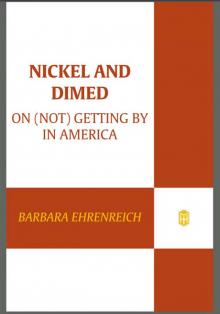 Nickel and Dimed: On (Not) Getting by in America
Nickel and Dimed: On (Not) Getting by in America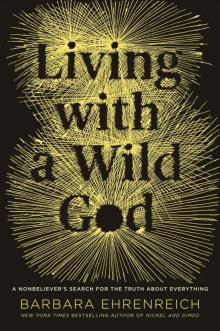 Living With a Wild God
Living With a Wild God Bright-Sided
Bright-Sided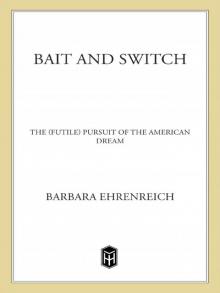 Bait and Switch: The (Futile) Pursuit of the American Dream
Bait and Switch: The (Futile) Pursuit of the American Dream Dancing in the Streets: A History of Collective Joy
Dancing in the Streets: A History of Collective Joy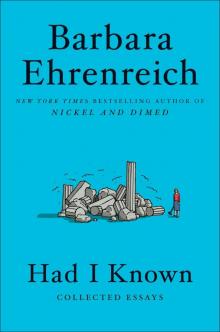 Had I Known
Had I Known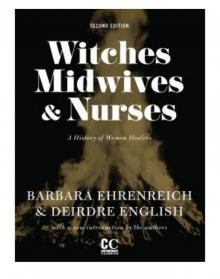 Witches, Midwives, and Nurses
Witches, Midwives, and Nurses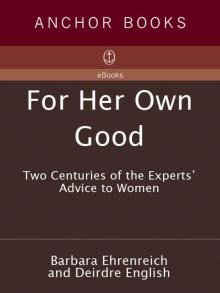 For Her Own Good: Two Centuries of the Experts Advice to Women
For Her Own Good: Two Centuries of the Experts Advice to Women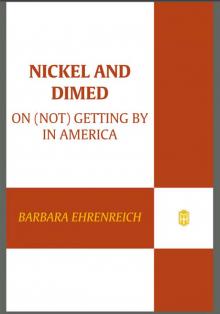 Nickel and Dimed
Nickel and Dimed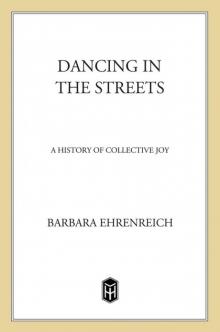 Dancing in the Streets
Dancing in the Streets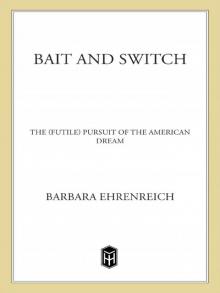 Bait and Switch
Bait and Switch